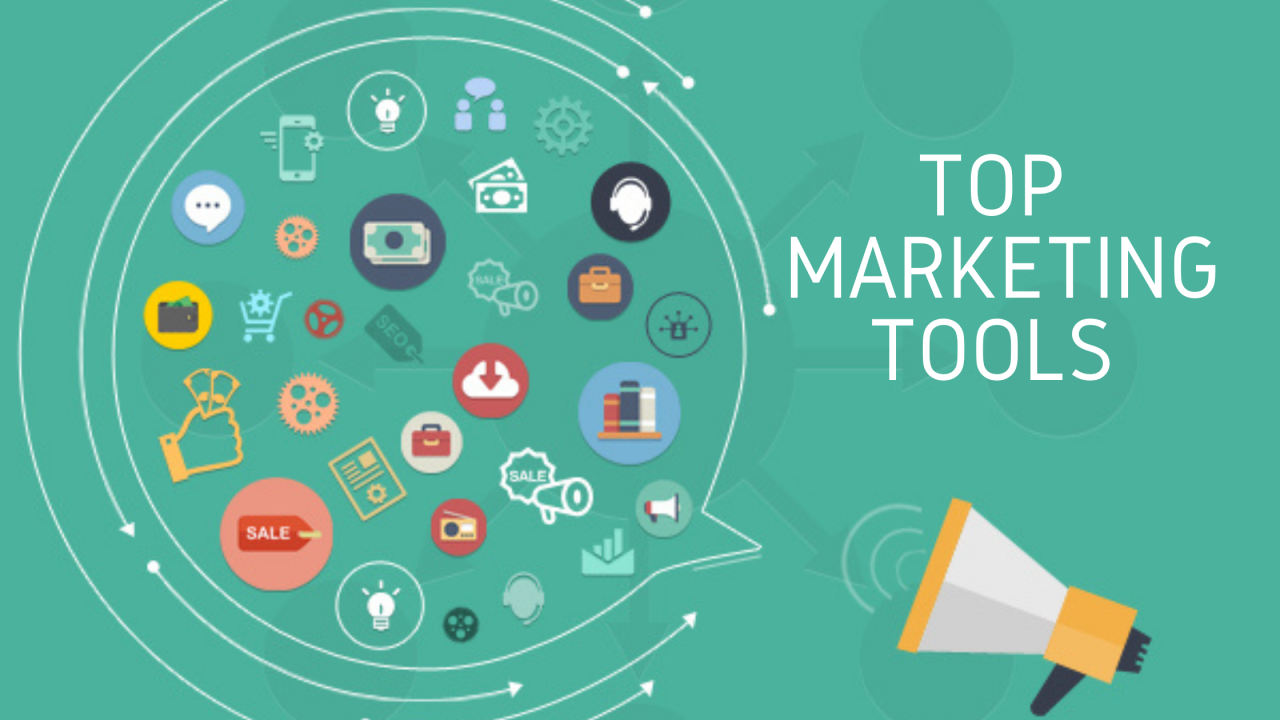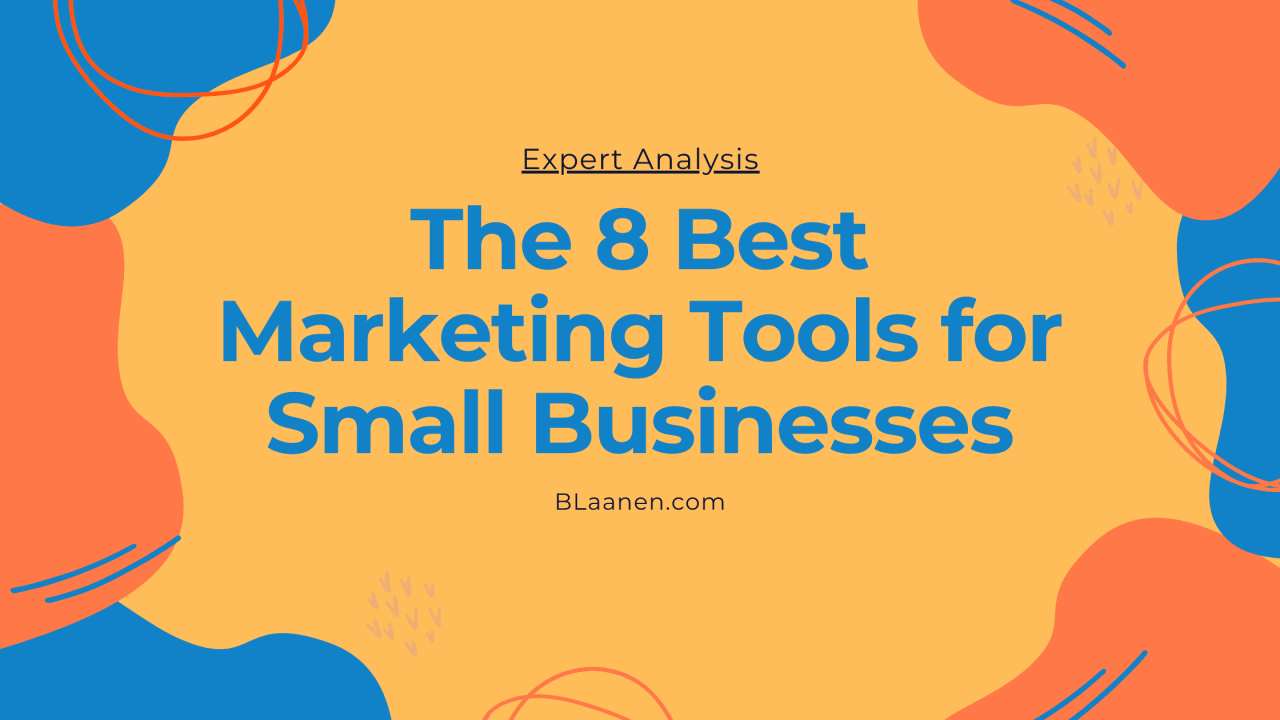Marketing Tools for Small Businesses – are crucial for success in today’s competitive landscape. This guide explores affordable options, effective social media strategies, content marketing techniques, website optimization, and crucial analytics for measuring and improving marketing efforts. We’ll delve into practical examples across various industries, providing actionable insights for small business owners seeking to expand their reach and boost their bottom line. From free tools to paid platforms, we’ll navigate the complexities of modern marketing, offering clear and concise strategies to help you achieve your business goals.
Affordable Marketing Tools

Marketing Tools for Small Businesses often operate on tight budgets, making cost-effective marketing crucial for success. Fortunately, numerous tools are available that offer powerful features without breaking the bank. This section explores several affordable options and examines the trade-offs between free and paid solutions.
Free and Low-Cost Marketing Tools for Small Businesses
Choosing the right marketing tools is vital for a small business’s growth. The following table lists five options offering a balance of functionality and affordability.
| Tool Name | Key Features | Pricing | Limitations |
|---|---|---|---|
| Google My Business | Manage online presence, receive reviews, post updates, track performance. | Free | Limited advanced analytics compared to paid options; relies on accurate and consistent information updates. |
| Canva | Create visually appealing graphics, social media posts, presentations, and more. Offers pre-designed templates. | Free (with paid options for premium features) | Limited access to advanced design features and stock photos in the free version. |
| Mailchimp (Free Plan) | Email marketing automation, subscriber management, basic campaign creation. | Free (with paid options for increased features and subscriber limits) | Limited email sending volume and advanced features in the free plan. |
| Hootsuite (Free Plan) | Social media management, scheduling posts, monitoring mentions across multiple platforms. | Free (with paid options for more users and features) | Limited number of social media accounts and features in the free plan. |
| Google Analytics | Website traffic analysis, user behavior tracking, conversion tracking. | Free | Requires some technical knowledge to set up and interpret data effectively. |
Free Versus Paid Marketing Tools for a Small Bakery
For a small bakery, the decision between free and paid marketing tools involves weighing cost against functionality. Free tools like Google My Business and Canva provide essential services for building online presence and creating marketing materials. However, paid tools offer scalability and advanced features that become increasingly important as the bakery grows. For example, a paid email marketing platform might allow for more sophisticated segmentation and automation, leading to more targeted campaigns and higher conversion rates. The initial investment in paid tools might be significant, but the potential return on investment can outweigh the costs in the long run, especially with features like A/B testing and detailed performance reporting unavailable in free versions.
Comparison of Email Marketing Tools for Small Businesses Platforms
Effective email marketing is crucial for building customer loyalty and driving sales. The following chart compares three popular email marketing platforms.
| Platform | Ease of Use | Automation Capabilities | Reporting Features |
|---|---|---|---|
| Mailchimp | User-friendly interface, intuitive drag-and-drop editor. | Automated email sequences, triggered emails based on user behavior. | Comprehensive campaign performance reports, including open rates, click-through rates, and conversions. |
| Constant Contact | Relatively easy to use, good for beginners. | Automated email sequences, list segmentation for targeted campaigns. | Detailed email campaign reports, including subscriber engagement metrics. |
| ConvertKit | Slightly steeper learning curve compared to Mailchimp and Constant Contact. | Advanced automation features, including tagging and custom workflows. | Robust reporting and analytics, focused on subscriber behavior and conversion tracking. |
Social Media Marketing Strategies: Marketing Tools For Small Businesses
Effective social media marketing is crucial for small businesses to reach their target audience and drive sales. By understanding the nuances of each platform and tailoring content accordingly, small businesses can maximize their reach and impact. This section explores effective strategies for different platforms, demonstrates a sample content calendar, and emphasizes the importance of consistent branding.
Social Media Strategies for a Small Clothing Boutique
A small clothing boutique can leverage the unique strengths of various social media platforms to boost brand awareness and sales. A multi-platform approach allows for a broader reach and targeted messaging.
- Instagram: Instagram’s visual nature makes it ideal for showcasing clothing. Strategies include high-quality product photography, behind-the-scenes glimpses of the boutique, user-generated content (reposting customer photos), and Instagram Stories featuring styling tips or limited-time offers. For example, a daily “outfit of the day” post featuring a different product each day, styled in various ways, can engage followers. Running targeted Instagram ads based on demographics and interests can further expand reach.
- Facebook: Facebook offers opportunities for community building and targeted advertising. Strategies include creating a Facebook group for loyal customers, running contests and giveaways, and using Facebook Ads to target specific demographics. For example, a “style quiz” on Facebook could help segment the audience and suggest products based on their preferences. Live videos showcasing new arrivals or styling sessions can also boost engagement.
- TikTok: TikTok’s short-form video format is perfect for showcasing trends and creating engaging content. Strategies include creating short, catchy videos featuring clothing items, partnering with fashion influencers, and utilizing trending sounds and hashtags. For example, a video showcasing a quick outfit change using different pieces from the boutique’s collection, set to a trending song, can quickly go viral. Collaborating with micro-influencers who align with the boutique’s brand can also greatly expand reach.
Sample Social Media Content Calendar for a Pet Grooming Business, Marketing Tools for Small Businesses
A consistent content calendar ensures regular posting and keeps the business top-of-mind for potential customers. This sample calendar focuses on a mix of content types to maintain engagement.
| Day | Platform | Content Type | Content Idea |
|---|---|---|---|
| Monday | Image Post | Before & After photo of a groomed pet | |
| Tuesday | Video | Short video showcasing the grooming process | |
| Wednesday | Story | Quick poll asking about pet grooming preferences | |
| Thursday | TikTok | Short Video | Cute pet doing something funny, related to grooming |
| Friday | Post | Special offer or promotion for the weekend | |
| Saturday | Carousel Post | Showcasing different grooming services | |
| Sunday | All Platforms | Share Client Testimonials | Positive reviews from happy clients |
Importance of Consistent Branding Across Social Media Platforms
Maintaining a consistent brand image across all social media platforms is essential for building recognition and trust. A unified brand identity reinforces professionalism and creates a cohesive customer experience.
- Successful Implementations: Companies like Starbucks consistently use their logo, color palette (green and white), and tone of voice across all platforms. Their imagery often features warm lighting and comfortable settings, aligning with their brand identity. This creates a recognizable and reassuring brand experience for their customers regardless of the platform.
- Pitfalls to Avoid: Inconsistent logos, different color schemes, and varying brand voices across platforms can confuse customers and dilute the brand’s message. For instance, using a casual tone on Instagram but a formal tone on Facebook can create a disjointed brand image. A lack of consistency can also lead to decreased brand recall and customer engagement.
Content Marketing and

Content marketing and are intertwined strategies crucial for small businesses to thrive online. By creating high-quality, relevant content and optimizing it for search engines, businesses can attract organic traffic, build brand awareness, and ultimately drive sales. This involves understanding your target audience, crafting compelling narratives, and employing effective techniques to ensure your content is easily discoverable.
Local Benefits for a Small Restaurant
Optimizing a small restaurant’s online presence for local searches is paramount for attracting nearby customers. A robust local strategy ensures the restaurant appears prominently in Google Maps and local search results when potential diners search for “restaurants near me,” “best Italian food,” or similar terms. This increased visibility translates directly into more foot traffic and online orders. Effective local involves claiming and optimizing Google My Business profile, ensuring consistent NAP (Name, Address, Phone number) information across all online listings, encouraging customer reviews, and building high-quality, location-relevant content, such as blog posts about local events or seasonal menus. For example, a pizza place could write a blog post titled “Top 5 Date Night Spots Near Our Pizzeria” to attract customers looking for romantic dining experiences. This creates a connection between the restaurant and the community.
Informative Video Topics for a Small Plumbing Company
A series of informative videos can significantly boost a plumbing company’s visibility and establish its expertise. Videos are engaging and easily shareable, reaching a broader audience than traditional marketing methods. Consistent uploads also improve a YouTube channel’s ranking in search results.
- Common Plumbing Problems and DIY Solutions: This video could cover simple fixes like unclogging a drain or repairing a leaky faucet, establishing the company as a helpful resource.
- Water Heater Maintenance and Troubleshooting: This video would demonstrate the importance of regular maintenance and show how to identify and address common water heater issues.
- Preventing Frozen Pipes in Winter: This video would offer practical tips and advice on how to protect pipes from freezing during cold weather, a crucial concern for many homeowners.
- Understanding Your Plumbing System: This educational video could explain the basic components of a plumbing system, making the company appear knowledgeable and trustworthy.
- Company Introduction and Team Highlights: A short video showcasing the company’s history, team members, and commitment to customer service builds personal connection and trust.
Creating High-Quality, Shareable Content for a Handcrafted Jewelry Business
High-quality, shareable content is vital for a handcrafted jewelry business to attract and engage its target audience. This involves showcasing the unique craftsmanship, storytelling behind the pieces, and building a strong brand identity.
High-resolution photography and videography are crucial to showcase the intricate details and beauty of the jewelry. Each piece should be presented in a visually appealing way, ideally against a neutral background to avoid distractions. Videos could show the jewelry being worn, the crafting process, or the designer’s inspiration. The content should also incorporate compelling narratives about the inspiration behind the pieces, the materials used, and the craftsmanship involved. Engaging social media posts featuring customer testimonials and behind-the-scenes glimpses into the creative process can foster a strong connection with the audience. For instance, a post could feature a customer wearing a necklace, accompanied by a story about the necklace’s significance to the customer. This personal touch enhances the brand’s story.
Website and Online Presence

A strong online presence is crucial for any small business, acting as a virtual storefront and a primary communication channel. A well-designed website and targeted online strategies can significantly impact a company’s visibility, credibility, and ultimately, its success. This section explores essential elements for building a user-friendly website and creating effective online marketing materials.
Essential Elements of a User-Friendly Website for a Small Consulting Firm
A user-friendly website for a small consulting firm should prioritize clarity, professionalism, and ease of navigation. Visitors should quickly understand the firm’s services and expertise, and find contact information effortlessly.
Navigation: The website’s navigation should be intuitive and straightforward. A clear menu with easily identifiable categories (e.g., “Services,” “About Us,” “Case Studies,” “Contact”) is essential. Internal linking between pages should be seamless, allowing users to explore the website logically. Consider a mega-menu for larger sites to improve organization and accessibility.
Design: The design should reflect the firm’s brand identity and professional image. A clean, modern layout with high-quality visuals (professional photography or illustrations) will create a positive first impression. Consistent use of branding elements (logo, color palette, typography) reinforces brand recognition. Avoid cluttered layouts and excessive animations that can slow down loading times.
Call-to-Actions (CTAs): Clear and compelling CTAs are crucial for guiding visitors towards desired actions. These could include “Request a Consultation,” “Download Our Brochure,” or “Learn More.” CTAs should be strategically placed throughout the website, using visually appealing buttons or text links.
Creating a Simple, Effective Landing Page for a Handmade Soap Online Store
A landing page for a handmade soap online store should focus on converting visitors into customers. It should highlight the unique selling propositions of the soaps, showcase high-quality product photography, and provide a seamless purchasing experience.
Headline and Subheadline: A compelling headline immediately grabs attention and communicates the value proposition. A concise subheadline expands on the headline, providing further details and benefits. For example, a headline could be “Luxurious Handmade Soaps for Pampered Skin,” and the subheadline could be “Naturally crafted with organic ingredients, leaving your skin feeling soft and rejuvenated.”
Product Showcase: High-quality product photography is crucial. Showcasing the soaps from various angles, highlighting textures and colors, will entice potential buyers. Include brief descriptions highlighting key features and benefits of each soap.
Clear Call-to-Action: A prominent “Add to Cart” button should be clearly visible for each product. A clear and concise checkout process is essential for minimizing cart abandonment.
Optimizing a Small Business Website for Mobile Devices
Mobile optimization is no longer optional; it’s essential. A responsive design ensures the website adapts seamlessly to different screen sizes and devices, providing a consistent user experience across all platforms.
Responsive Design: Responsive design uses flexible layouts and CSS media queries to adjust the website’s appearance based on the device’s screen size. This ensures the website is easily navigable and readable on smartphones, tablets, and desktops.
User Experience (UX): Mobile UX should prioritize simplicity and ease of navigation. Large, tappable buttons, clear typography, and minimal scrolling improve the user experience. Avoid using excessive animations or interactive elements that can slow down loading times on mobile devices.
Testing: Regularly test the website’s responsiveness on various devices and browsers to identify and fix any issues. Tools like Google’s PageSpeed Insights can help assess the website’s performance and identify areas for improvement.
Analyzing Marketing Results and Adjustments
Understanding and responding to marketing campaign performance is crucial for small businesses. Effective analysis allows for optimization, maximizing return on investment (ROI) and ensuring marketing efforts align with business goals. This involves tracking key metrics, interpreting data from various sources, and adapting strategies based on the insights gained.
Key Performance Indicators (KPIs) for a Coffee Shop
Three essential KPIs for a small coffee shop marketing campaign are customer acquisition cost (CAC), average order value (AOV), and customer retention rate. Tracking these provides a comprehensive view of campaign effectiveness. CAC measures the cost of acquiring a new customer, helping to assess the efficiency of marketing spend. AOV reflects the average amount spent per transaction, indicating the success of upselling and cross-selling efforts. Finally, customer retention rate shows the percentage of customers who return for repeat purchases, demonstrating the loyalty and overall satisfaction generated by the marketing campaign. By monitoring these KPIs, the coffee shop can identify areas for improvement and optimize its marketing strategy for greater profitability.
Interpreting Website Analytics for a Photography Studio
Website analytics, such as those provided by Google Analytics, offer invaluable insights for a photography studio’s online marketing. Analyzing data like website traffic sources, bounce rate, time on site, and conversion rates (e.g., inquiries, bookings) helps understand user behavior and campaign effectiveness. A high bounce rate, for instance, might indicate issues with website design or content relevance, prompting adjustments to website usability and . Low conversion rates could suggest a need for clearer calls-to-action or improved website functionality. Conversely, identifying high-performing content or marketing channels (e.g., social media, search engine optimization) allows for resource allocation to optimize these channels further. Analyzing geographic data can also help target marketing efforts towards specific regions with high engagement.
Adapting Marketing Strategies Based on Customer Feedback for a Fitness Center
Customer feedback, gathered through surveys, reviews, and social media interactions, provides crucial insights into customer satisfaction and areas for improvement. For a fitness center, negative feedback regarding class scheduling might lead to adjustments in class times or the introduction of new class formats based on popular requests. Low attendance for specific classes could indicate a need for better promotion or a review of class content. Positive feedback, on the other hand, can be leveraged in marketing materials to highlight popular aspects of the fitness center, building credibility and attracting new members. For example, consistently positive reviews about a particular instructor could be incorporated into advertising campaigns to emphasize the quality of instruction. Analyzing customer feedback helps the fitness center tailor its offerings and marketing messages to better meet customer needs and expectations.
Ultimately, effective marketing for small businesses hinges on a strategic blend of affordable tools, engaging content, and consistent analysis. By leveraging the resources and strategies Artikeld in this guide, small businesses can create a powerful online presence, connect with their target audiences, and drive sustainable growth. Remember that consistent effort, adaptation based on data, and a clear understanding of your target market are key ingredients for success in the dynamic world of small business marketing.
Effective marketing tools are crucial for small businesses to reach their target audience. A key strategy involves coordinating messages across various platforms, which is where understanding the nuances of developing effective cross-channel campaigns becomes vital. Learning how to create these integrated campaigns is essential, and a great resource for this is Developing Cross-Channel Campaigns , which can help you leverage your marketing tools more effectively.
Ultimately, mastering cross-channel marketing significantly boosts the return on investment for your small business’s marketing efforts.
Effective marketing tools are crucial for small businesses to thrive. A strong online presence is paramount, and this often involves leveraging social media platforms. To maximize your reach, consider exploring proven techniques outlined in this excellent guide on Top Social Media Strategies , which will help you develop a robust social media plan. Ultimately, integrating these strategies with other marketing tools will yield the best results for your small business.